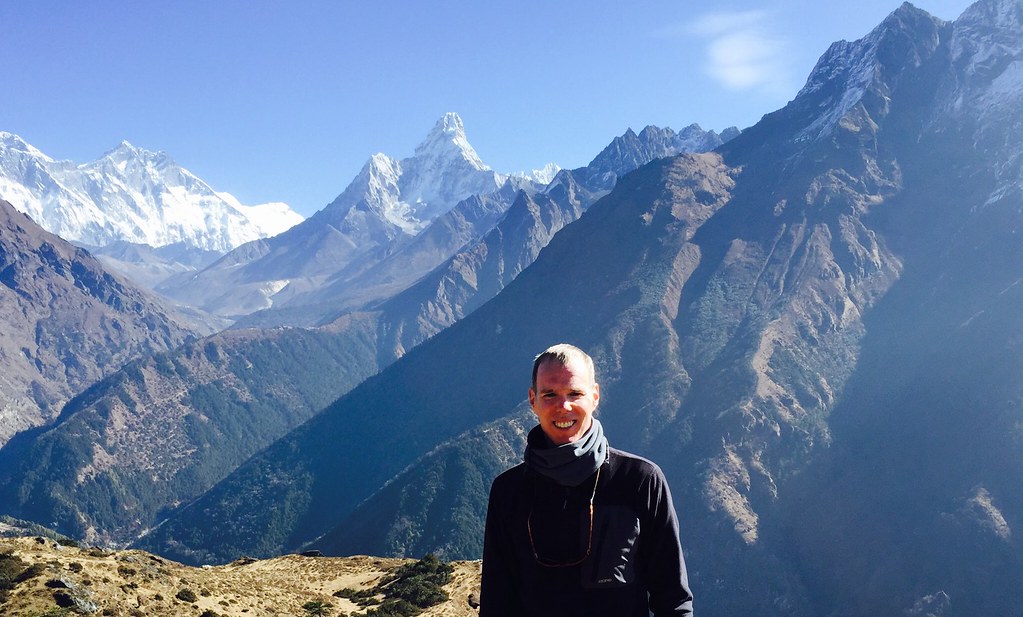After completing my trekking, I've had a couple of days to spend wandering around Kathmandu and checking out some of the historic sites that I had not yet had time to venture to previously.
On Monday I went to Durbar Square. Here again, I've dipped into Lonely Planet to share some background on this historic site (the pictures are mine however and clearly show that many of the historic buildings were damaged in the earthquake and have temporary support structures to hold them up during repairs):

Kathmandu’s Durbar Square was where the city’s kings were once crowned and legitimised, and from where they ruled (‘durbar’ means palace). As such, the square remains the traditional heart of the old town and Kathmandu’s most spectacular legacy of traditional architecture.
It’s easy to spend hours wandering around the square and watching the world go by from the terraced platforms of the towering Maju Deval; it’s a wonderful way to get a feel for the city. Although most of the square dates from the 17th and 18th centuries (many of the original buildings are much older), a great deal of rebuilding happened after the great earthquake of 1934. The entire square was designated a Unesco World Heritage Site in 1979.
The Durbar Sq area is actually made up of three loosely linked squares. To the south is the open Basantapur Sq area, a former royal elephant stables that now houses souvenir stalls and off which runs Freak St. The main Durbar Sq area, with its popular watch-the-world-go-by temples, is to the west. Running northeast is a second part of Durbar Sq, which contains the entrance to the Hanuman Dhoka and an assortment of temples. From this open area Makhan Tole, at one time the main road in Kathmandu and still the most interesting street to walk down, continues northeast.

A good place to start an exploration of the square is with what may well be the oldest building in the valley, the unprepossessing Kasthamandap.
Read more: http://www.lonelyplanet.com/nepal/kathmandu/sights/historic/durbar-square#ixzz3sTB3mpFA
Yesterday, I went to Swayambhunath, also known as the Monkey Temple. Per Lonely Planet:

A journey up to the Buddhist temple and Unesco World Heritage Site of Swayambhunath is one of the definitive experiences of Kathmandu. Mobbed by monkeys and soaring above the city on a lofty hilltop, the ‘Monkey Temple’ is centred on a gleaming white stupa, topped by a gilded spire painted with the eyes of the Buddha. Depictions of these eyes appear all over the Kathmandu Valley.
Coming to Swayambhunath is an intoxicating experience, with ancient carvings jammed into every spare inch of space and the smell of incense and butter lamps hanging heavy in the air. The mystical atmosphere is heightened in the morning and evening by local devotees who make a ritual circumnavigation of the stupa, spinning the prayer wheels set into its base. It is a great place to watch the sun set over Kathmandu.

Read more: http://www.lonelyplanet.com/nepal/around-the-kathmandu-valley/swayambhunath/sights/religious/swayambhunath-temple#ixzz3sTDAUxDY
- Posted using BlogPress from my iPhone
Location:Jyatha,Kathmandu,Nepal

 Namaste is kind of like a praise to the person or people receiving the namaste. The word's meaning is “I bow to the divine in you" or "the spirit within me salutes the spirit within you." Namaste is a traditional Indian/Nepali greeting of respect and thank you, with spiritual and symbolic meaning. Namaste is usually spoken with a slight bow and hands pressed together, palms touching and fingers pointing upwards, thumbs close to the chest. It is used for both salutations (greetings) and valedictions (farewells).
Namaste is kind of like a praise to the person or people receiving the namaste. The word's meaning is “I bow to the divine in you" or "the spirit within me salutes the spirit within you." Namaste is a traditional Indian/Nepali greeting of respect and thank you, with spiritual and symbolic meaning. Namaste is usually spoken with a slight bow and hands pressed together, palms touching and fingers pointing upwards, thumbs close to the chest. It is used for both salutations (greetings) and valedictions (farewells).





















